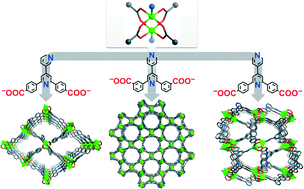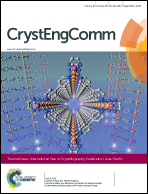New porous coordination polymers based on expanded pyridyl-dicarboxylate ligands and a paddle-wheel cluster†
Abstract
Solvothermal reactions of Cu(NO3)2 and 4,4′-([3,4′-bipyridine]-2′,6′-diyl)dibenzoic acid (H2L1), 3,3′-([4,4′-bipyridine]-2,6-diyl)dibenzoic acid (H2L2), or 4,4′-([4,4′-bipyridine]-2,6-diyl)dibenzoic acid (H2L3) yielded three new metal-carboxylate frameworks (MCF-28, MCF-29 and MCF-30) with a common formula [Cu2(L)2] (H2L = pyridyldicarboxylic acid). X-ray crystallography showed that MCF-28, MCF-29, and MCF-30 are three-dimensional (3,6)-connected rtl, eea and pyr networks, respectively, based on 3-connected tripodal ligands and 6-connected Cu2(RCOO)4(py)2 units (RCOO and py denote carboxylate and pyridyl groups, respectively). Thermogravimetry, powder X-ray diffraction, and gas adsorption measurements indicated that the three compounds became shrunk and amorphous structures after guest removal. Interestingly, single-crystal X-ray diffraction showed that MCF-28 exhibited drastic temperature-induced framework breathing.

- This article is part of the themed collection: International Year of Crystallography Celebration: Asia-Pacific

 Please wait while we load your content...
Please wait while we load your content...